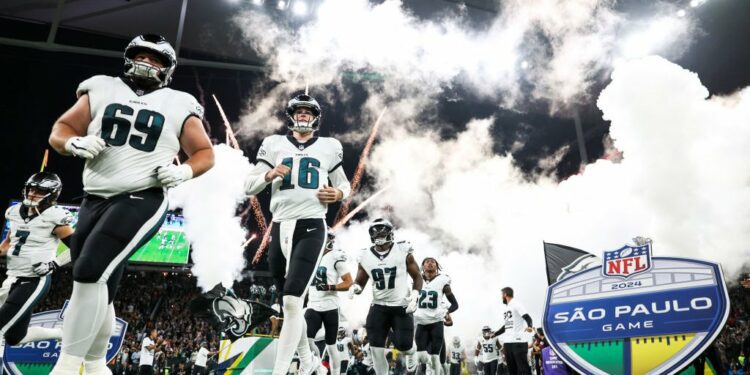In 1894, Charles Miller, the son of a Scottish railway engineer working in São Paulo, returned from boarding school back in England bearing two soccer balls and a rulebook for the varietal of football that was taking Britain by storm. Miller established the Sao Paolo Athletic Club and organized the country’s first football league—a decidedly posh affair in its early years, long before the jogo bonito would become synonymous with Brazil and the inspirational power of a poor man’s game.
One hundred and thirty years later, the NFL played its first game in Brazil—its first game in South America, for that matter—on Sept. 6, in the sprawling metropolis of São Paolo, and Charles Miller would have been impressed. An enthusiastic sell-out crowd of almost 50,000 watched the Philadelphia Eagles beat the Green Bay Packers at the Neo Quimica Arena, a futuristic stadium built for the 2014 FIFA Men’s World Cup.
“Tickets were harder to come by than tickets for Taylor Swift last fall,” Ubiratan Leal, an ESPN Brazil analyst, told me, “but that’s partly because she played three consecutive nights in São Paolo, and the NFL only played once.” He says younger Brazilians are more connected to American culture, and following the NFL is a clear way to signal one’s “cosmopolitanism.” ESPN and other media outlets in Brazil broadcast weekly NFL games, and the internet and social media make it a lot easier for fans a continent away to feel connected to the action.
Read more: Patrick Mahomes Is Already Thinking About His Next Super Bowl Win
At a time when the United States runs the danger of being perceived as an arrogant, self-obsessed superpower, the nation’s newfound enthusiasm to both share its football with new markets and to adapt the world’s version of the sport provides a powerful counter-narrative. Geopolitical strategists dismiss the power of sport at their own peril; it is arguably the most potent form of what the political scientist Joseph Nye famously termed “soft power.” That’s why regimes including Putin’s Russia, Communist China, and the wealthy monarchies of the Persian Gulf have invested so heavily through the years to associate themselves—much in the same way automakers or beer brands do—with sport.
To wit, Roger Goodell isn’t a U.S. diplomat, but he is doing more than his fair share to make the United States more relatable and likable to people around the world as he pursues commercial growth for his business. I witnessed this dynamic as a kid growing up in Mexico. The traditional anti-American rhetoric that had long been a staple of Mexico’s political discourse lost much of its sting once you had millions of Mexicans cheering on the Dallas Cowboys or Pittsburgh Steelers. Conversely, the fact that NFL franchises are eager to host the 2026 FIFA Men’s World Cup in their stadiums, and that Apple and other U.S. brands invested a fortune to bring Leo Messi to Miami, also conveys to people around the world that 21st Century America wants to play with them.
And it isn’t hard to see why Goodell chose Brazil to help make that statement, with a marquee match-up on the Friday night of the regular season’s opening weekend. A nation of 215 million people, Brazil boasts the world’s eighth largest economy, and a sporting passion and global sporting soft power second to none. The NFL estimates it already has more fans in Brazil than anywhere outside of the United States and Mexico. The league has been far more successful than any other at monetizing fans’ interest in its domestic market, but it is a sign of America’s historic sports isolationism that the U.S. still accounts for more than half of the Super Bowl’s TV audience each year. That is in stark contrast to other icons of American pop culture that have gone truly global—Taylor Swift, Hollywood’s Marvel blockbusters, products like Coca-Cola—and have more fans and consumers outside the United States than within. The NFL wants to follow in their footsteps.
A few years ago, Goodell convinced NFL club owners to add a 17th regular season game, to free them up for more international duty without asking them to sacrifice precious home games. In addition to São Paolo, the NFL will play three games in London this season, and one in Munich. Next year it will debut in another one of the other football’s most imposing citadels: Real Madrid’s Santiago Bernabeu Stadium. The league wants to ramp up to at least eight international games a season.
As it often does in Super Bowl cities, the NFL hosted a series of community activities in São Paolo, and an interactive “NFL Experience” at Parque Villa-Lobos, where fans could admire the Vince Lombardi trophy, try their luck at field goals, long snaps, precise throws, play some flag football, and watch some of the other games throughout the weekend. Fans milling about wore jerseys of just about every NFL franchise.
Victor Romanelli, a Steelers-loving English teacher standing in line for his close-up with the Lombardi trophy, told me he first connected with the Pittsburgh team as a Wiz Khalifa fan who wondered what the rapper’s “Black and Yellow” song was about. That’s all it took.
The NFL isn’t shy about proclaiming that its “product” is the most riveting sport on TV, and that with enough exposure to it, people anywhere, even in lands long identified with the other football, will tune in. But what is surprising about the NFL’s current outreach in Brazil, and elsewhere, is that it isn’t just peddling its gladiatorial spectacle.
The league is also pushing 5-on-5 flag football. It was the central attraction at the NFL Experience, and the Eagles hosted their own afternoon community event two days before the game, inviting kids from across the country to do flag drills wearing Eagles t-shirts, encouraged by the team’s cheerleaders and the team’s “Fly, Eagles Fly” fight song blaring over the loudspeakers. Pierre Trochet, the president of the International Federation of American Football, which is (naturally) based in France and organizes both tackle and flag football globally, was there. Flag will be featured at the Los Angeles Olympics for the first time, and Trochet is confident it will retain that status beyond 2028.
“We have some 20 million people playing flag football in 100 countries,” he said. “In Mexico alone, 100,000 kids pick up the game each year.”
Flag football helps the sport overcome three obstacles to rapid global expansion. There aren’t the same health concerns at play; the game is gender-inclusive; and the equipment cost barrier is drastically lowered.
Read more: The Man Who Changed Field Goals Forever
At a forum I participated in at São Paolo’s Soccer Museum in three days before the game, Cris Kajiwara, the president of the Brazilian Confederation of American Football, said flag football is being taken up across Brazil, even in its most remote regions. She had recently returned from the IFAF’s 32-nation Flag Football World Championship in Finland and is bullish on the sport’s growth, especially now that it is an Olympic sport and thus more likely to get public support in many countries. And because it is a new sport without a long history of being a male preserve, girls feel especially welcome, and on equal footing.
The two football worlds are converging in other ways. The Green Bay Packers are the most throwback of NFL franchises. You could fit 213 Green Bays into metro Sao Paolo. And yet, its historic Lambeau Field has hosted a Manchester City vs. Bayern Munich friendly two summers ago. In a conversation recorded for the Great Game Lab at Arizona State University this summer, Mark Murphy, the Packers CEO, recalled that sold-out match as an extraordinary scene. What most surprised him was how excited his own players were, and how knowledgeable some of them were about European soccer.
As for the Packer fans who traveled to São Paolo, they were stunned to find so many impassioned Packer fans in Brazil, who seemed to get what makes their club so distinctive. David Wallschleager, who started following the Packers on the radio and graduated from high school one year before the iconic 1967 “ice bowl” championship game, told me he wouldn’t have missed this game for anything. He still remembers when people complained about $3 ticket prices but is now onboard for Roger Goodell’s global expansion: “This was good for this city, this country, and our team. I can’t wait to see where we go next.”
And who knows. The soccer team that regularly plays in the stadium that hosted the NFL’s São Paolo game was born in 1910 and named after a visiting English club, the Corinthians. Maybe someday another sport will try to make inroads in Brazil playing on a field normally played by the São Paolo Packers, who will be seen as a hyper-local institution playing an inherently Brazilian game.
Source link : http://www.bing.com/news/apiclick.aspx?ref=FexRss&aid=&tid=66e70dc471ea40468ba7c6f40324f54d&url=https%3A%2F%2Ftime.com%2F7021106%2Fnfl-brazil-global-expansion%2F&c=7199379797993639517&mkt=en-us
Author :
Publish date : 2024-09-15 05:00:00
Copyright for syndicated content belongs to the linked Source.












